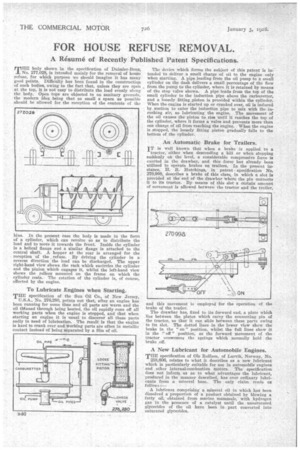FOR HOUSE REFUSE REMOVAL.
Page 64

If you've noticed an error in this article please click here to report it so we can fix it.
A Résumé of Recently Published Patent Specifications.
THE body shown in the specification of Daimler-Benz, No. 277,028, is intended mainly for the removal of house refuse, for which purpose we should imagine it has many good points. Difficulty has been found in the construction of such bodies, owing to the fact that, unless they are open at the top, it is not easy to distribute the load evenly along the body. Open tops are objected to on sanitary grounds, the modern idea being that as small a space as possible should be allowed for the reception of the contents of the bins. In the present case the body is made in the form of a cylinder, which can revolve so as to distribute the load and to move it towards the front. Inside the cylinder is a helical flange and a similar flange is attached to the central shaft. A hopper at the rear is arranged for the reception of the, refuse. By driving the cylinder in a reverse direction the load can be discharged. The upper right-hand view shows the rack which encircles the cylinder and the pinion which engages it, whilst the left-hand view shows the rollers mounted on the frame on which the cylinder rests. The rotation of the cylinder is, of course, effected by the engine.
To Lubricate Engines when Starting.
THE specification of the Sun Oil Co., of New Jersey, U.S.A.. No. 276,280, points out that, after an engine has been running for some time and all parts are warm and the oil thinned through being heated, the oil rapidly runs off all working parts when the engine is stopped, and that when starting an engine it is usual to discover all these parts sadly in need of lubrication. The result is that the engine is hard to crank over and Working parts are often in metallic contact instead of being separated by a film of oil. The device which forms the subject of this patent is intended to deliver a small charge of oil to the engine only when starting. A pipe leading from the oil pump to*a small cylinder on the dash delivers a small percentage of the flow from the pump to the cylinder, where it is retained by means of the stop valve shown. A pipe leads from the tap of the small cylinder to the induction pipe above the carburetter, and a loosely fitting piston is provided within the cylinder. When the engine is started up or cranked over, oil is induced by suction to enter the induction pipe to mix with the inrushing air, so lubricating the engine. The movement of the oil causes the piston to rise until it reaches the top of the cylinder, where it forms a valve and prevents more than one charge of oil from-reaching the 'engine. When the engine is stopped, the loosely fitting piston gradually falls to the bottom of the cylinder.
An Automatic Brake for Trailers.
IT is well known that when' a brake is applied to a tractor, either when descending a hill or when stopping suddenly oh the level, a considerable compressive force is exerted in the drawbar, and this force has already been utilized to operate brakes on trailers. In the present instance, H. 13. Hutchings, in patent specification No. 270,998, describes a brake of this class, in which a slot is provided at the and of the drawbar where the pin connects it to its tractor. By means of this slot a certain amount of movement is allowed between the tractor and the trailer,
and this movement is employed for the operation of brake of the trailer.
The drawbar has, fixed to its forward end, a plate which lies between the plates which carry the connectink pin of the tractor, so that it can slide between these parts owing • to its slot. The dotted lines in the lower view show the brake in the " on " position, whilst the full lines show it in the " off " position, as the forward movement of the tractor ovencomes the springs which normally hold the brake off. the
A New Lubricant for Automobile Engines.
THE specification of Ole Rolfsen, of Larvik, Norway, No.
258,606, relates to what it describes as a new lubricant which is particularly suitable for use in automobile engines and other internal-combustion motors. The specification does not inform us as to what advantages the lubricant, produced in the manner described, has over ordinary lubriCants from a mineral base. The only claim reads as follows :
A lubricant comprising a mineral oil in which has been dissolved a proportion of a product obtained by blowing a fatty ail, obtained from marine mammals, with hydrogen gas in the presence of a catalyst until the unsaturated glycerides of the oil have been in, part converted into saturated glycerides.




































































































